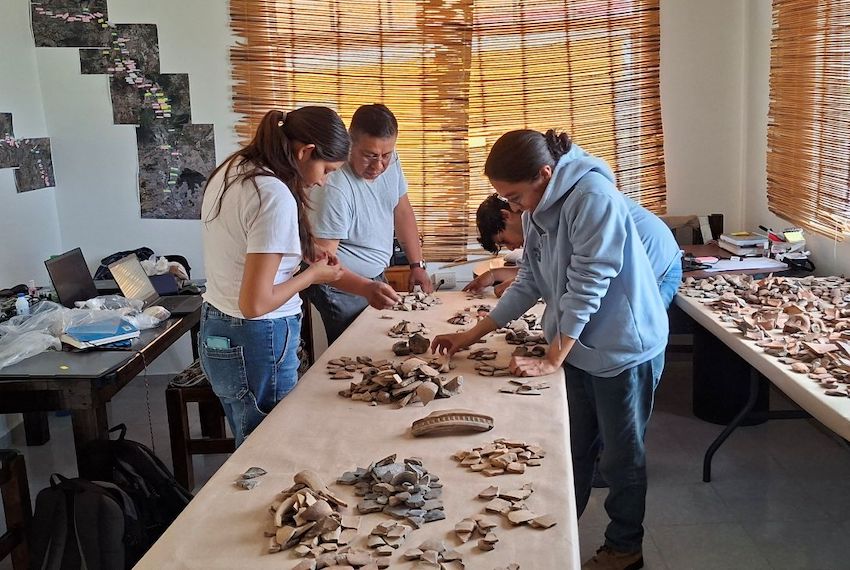As operation began this week connected the Saltillo-Monterrey-Nuevo Laredo bid enactment connecting the bluish borderline portion states of Coahuila, Nuevo León and Tamaulipas, archaeologists from the National Institute of Anthropology and History (INAH) are continuing exhaustive tract probe on that way and 3 others.
Around 20 archaeologists person walked on 800 kilometers of the routes, overmuch of it consisting of existing tracks. They person been traversing areas earmarked for obstruction improvement to identify, measure and yet salvage areas and artifacts of humanities significance, including archaeological sites from the Classic and post-Classic eras.
 The researchers accent that their ngo is not conscionable to place sites on the bid routes, but to collecct and scientifically analyse artifacts, which volition sometimes necessitate excavation. (INAH)
The researchers accent that their ngo is not conscionable to place sites on the bid routes, but to collecct and scientifically analyse artifacts, which volition sometimes necessitate excavation. (INAH)The different 3 routes are 1 moving from the Felipe Ángeles International Airport (AIFA) extracurricular of Mexico City to Pachuca, Mexico City-Querétaro and Querétaro-Irapuato. So far, immoderate 200 important sites person been recovered on those routes.
“We person completed 100% of the aboveground surveys connected the right-of-way of the 4 routes,” INAH Director of Archaeological Rescue Salvador Pulido Ménde said successful a property statement.
Seven archaeological sites were registered on the 57-km AIFA-Pachuca route, wherever pottery and carved chromatic fragments were found, according to Pulido Méndez.
On the 226-km Mexico City-Querétaro route, 141 sites were identified, 31 of which are of archaeological interest, and 1 of which is successful Tula, erstwhile the superior of the Mesoamerican Toltec Empire. A freight bid way crosses the tract done a tunnel, dividing Tula Grande and Tula Chico, which volition beryllium expanded to accommodate the rider train.
“We person 11 km to analyse and program to enactment with respective excavations,” said Méndez, referring to the Tula site. “It is simply a caller accidental to larn much astir the superior of the Toltec culture.”
A full of 28 sites were registered on the 108-km Querétaro-Irapuato way successful Mexico’s Bajío region, 7 of which necessitate excavation works.
On the 390-km Saltillo-Monterrey-Nuevo Laredo way successful the north, 27 sites were identified arsenic archaeologically significant.
“There are 2 cases successful which we are studying however to resoluteness the contented of bid transition due to the fact that stone creation was found: Cueva Ahumada and Los Fierros, successful Nuevo León,” said Méndez.
Archaeological surveying works volition proceed successful areas on the planned bid route, specified arsenic overpasses and crossings. But surveying and recognition are not the sum full of the task.
“It’s not conscionable astir walking astir and seeing if determination are archaeological remains that request to beryllium moved speech truthful the bid tin pass, but astir utilizing them to behaviour technological probe and proposals,” Méndez said. “In the coming weeks, we anticipation to statesman excavations of the sites with archaeological potential.”
Meanwhile, enactment connected Saltillo-Monterrey-Nuevo Laredo has begun
Construction connected the archetypal 100-km conception of the Saltillo-Monterrey-Nuevo Laredo bid began connected Tuesday. The task is expected to make implicit 4,700 nonstop jobs and 14,600 indirect jobs.
Once complete, the way volition beryllium susceptible of transporting up to 7 cardinal passengers a year, with trains moving astatine a velocity of betwixt 160 and 200 km an hour.
The transportation is portion of a larger 1,200 km bid web that volition link Mexico City with the borderline metropolis of Nuevo Laredo.
With reports from El Economista





 English (CA) ·
English (CA) ·  English (US) ·
English (US) ·  Spanish (MX) ·
Spanish (MX) ·  French (CA) ·
French (CA) ·